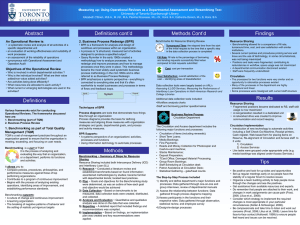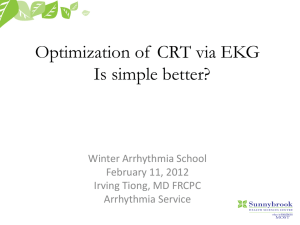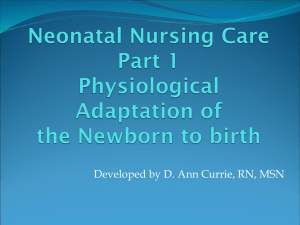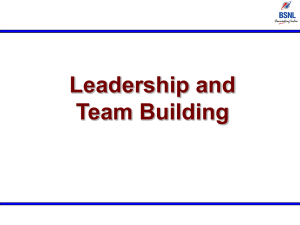Oxygenation and Circulation for Management of Oxygen
advertisement
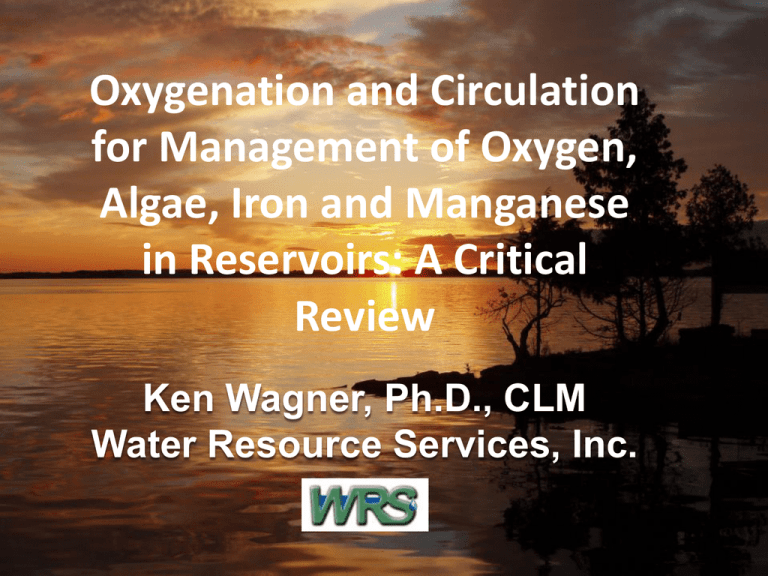
Oxygenation and Circulation for Management of Oxygen, Algae, Iron and Manganese in Reservoirs: A Critical Review Ken Wagner, Ph.D., CLM Water Resource Services, Inc. For complete details, see OXYGENATION AND CIRCULATION TO AID WATER SUPPLY RESERVOIR MANAGEMENT Prepared by Ken Wagner/NALMS For the Water Research Foundation (Available in early 2015) Two related but separate processes Oxygenation – any process that adds oxygen to target waters; circulation can do this if it increases contact with the atmosphere Circulation – any process that blends water; can be mechanical or air driven, usually induces oxygenation For the purpose of this review, Oxygenation= hypolimnetic aeration or nondestratifying oxygenation Circulation=mixing, either whole lake or partial Reasons to oxygenate or circulate Avoid low oxygen levels that foster undesirable water quality and increase treatment needs Elevated metals, especially iron and manganese Accumulations of ammonium, hydrogen sulfide Phosphorus release from sediment that supports algae growth Reduce algae biomass or change composition Provide consistent water quality (limit variation) Improve habitat, especially for fish and invertebrates Oxygenation is intended to: Increase oxygen levels to avoid anoxia and accumulation of reduced compounds Accelerate beneficial chemical changes to incoming loads of contaminants Provide habitat with sufficient oxygen Circulation is intended to: Homogenize water quality over target zone Facilitate oxygenation through increased transfer of oxygen from the atmosphere to surface water, and from bubbles if applied Limit plankton by movement in water column Keys to successful oxygenation Quantitatively counter oxygen demand Distribute the oxygen to where needed Biggest challenge is induced oxygen demand, created by movement of water in contact with sediment, which increases the rate of oxygen consumption. Ironically, action taken to satisfy oxygen demand causes increased demand. Keys to successful circulation Provide enough power to overcome thermal gradient Prevent stratification, as the energy necessary to break stratification is much greater than that necessary to maintain mixed conditions Biggest challenge is the thermal gradient induced by sunlight on the water surface; heat input from a series of hot sunny days is greater than the mixing power supplied by nearly all systems. Oxygenation Approaches: HAC Hypolimnetic aeration chambers popular in 1980s1990s, potentially effective but not overly efficient Non-destratifying, increased bottom DO, some undersizing but more distribution/maintenance issues If internally supplied P is dominant source, may control algae; need to understand seasonal P loading Oxygenation Approaches: HAC with a twist Layer Air (ECS creation) allows creation of a thermally distinct, oxygenated layer Pulls in oxygen-rich upper waters and adds oxygen to oxygen-poor lower waters, creating intermediate layer Does not need to address entire oxygen deficit to achieve desired conditions at targeted depth Upper waters “New” layer Lower waters Oxygenation Approaches: DOX Pure oxygen diffusers - simplicity of diffuser system with efficiency of oxygen transfer Oxygenation Approaches: DOX Pure oxygen released as small bubbles, dissolve before causing destratification Can be done without pumps, min power use; gaseous oxygen moves by own pressure Oxygenation Approaches: DBC or Speece cone Oxygen injected into chamber with low DO water flowing downward, ideally bubbles held in position until dissolved (must balance oxygen and water flow) Distribution of oxygen is key issue; movement across density gradient is limited Oxygenation Approaches: SSS Can also super-oxygenate outside water body and inject the water where desired Distribution remains the key issue, but density differences might be used to advantage Oxygenated water tends to move within density layer more than across gradient to areas of lower oxygen Circulation Methods: DAC Air diffuser systems highly varied, very common – effective when properly sized, distributed and operated; compressors are usually the weak link Oxygenation through interaction with atmosphere is usually more important than transfer from bubbles (<3% transfer/meter); need 1.3 cfm/ac to mix well Circulation Methods: UDP Updraft mixers tend to be small, low power systems, run by electricity, wind or solar Efficiently move water Possible compensatory circulation patterns at distance from mixer limited by thermal gradient Limited corroborating data Circulation Methods: Fountains Fountains – a form of upflow mixing, aerate well, but usually a small volume per unit time; need enough capacity to move the target water volume Not common in larger lakes or reservoirs Circulation Methods: DDP Downdraft mixers with wide size range, force oxygenated surface water into deep areas Can be solar or wind powered, but run efficiently on electricity Data indicate substantial mixing and oxygenation if system large enough, but limited by thermal gradients Experience with Oxygenation and Circulation Evaluated case histories for range of applications Many utilities contributed Considered effectiveness, constraints, costs Experience with Oxygenation and Circulation Oxygen, algae, iron and manganese are the main reasons for oxy/circ systems in water supplies Oxygen for habitat often important to power producers Experience with Oxygenation and Circulation Strong performance by DOX, DBC and SSS systems, mostly partial success with HAC Mixed results with circulation systems, DDP have done best, UDP have done worst Success linked to both system features and operational considerations Experience with Oxygenation and Circulation Hypolimnetic Aeration Chambers Flexible operation, added oxygen always a benefit, maintain stratification Systems are not efficient; <30% of the oxygen in added air stays in water Compressor failures frequent; cannot afford to have system off for long during summer With expensive structures on land and in water, capital cost is substantial Power is main operational cost factor Good control of Fe, partial for Mn, impacts algae types more than quantity Experience with Oxygenation and Circulation Diffused Oxygen Flexible operation, added oxygen always a benefit, maintains stratification Systems are efficient; >85% of the added oxygen stays in water if target layer thick Minimal moving parts and no power requirement to move oxygen into water Expensive structures on land, access for maintenance is easy Oxygen is main operational cost factor Very good control of Fe and Mn, algal control depends on external loading Experience with Oxygenation and Circulation Downflow Bubble Contactors (Speece cone) Targeted operation, added oxygen always a benefit, maintain stratification Systems are efficient; >85% of the added oxygen stays in water Can create oxygenated layer of variable thickness near bottom Oxygen source and pumps for water needed, possibly expensive installation Power and oxygen are ops cost factors Very good control of Fe and Mn, algal control depends on external loading Experience with Oxygenation and Circulation Sidestream Super Saturation Targeted operation, added oxygen always a benefit, maintains stratification Systems are efficient; >90% of the added oxygen stays in water Thin layer on bottom with density control Withdrawal and input pipes in reservoir, but land based equipment can be expensive Power and oxygen are main operational cost factors Very good control of Fe and Mn, algal control depends on external loading Experience with Oxygenation and Circulation Diffused Air Circulation Flexible operation, added air both oxygenates and mixes, difficult to mix right at bottom Systems are more efficient when in deeper water; more piping necessary for distribution in shallow water Compressor failures frequent; cannot afford to have system off for long during summer Capital cost varies; many diffuser options Power is main operational cost factor Moderate Fe and Mn control, may shift algae types without lowering biomass Experience with Oxygenation and Circulation Updraft Circulation Targeted operation, tend to address small area/volume, often avoids bottom layer Systems are efficient; water moved at low cost, especially with solar versions Poor quality water pulled from bottom affects surface water quality; must have ongoing adequate circulation, sizing critical Circulation of algae can provide some control without oxygenation function Limited Fe and Mn control, may shift algae types without lowering biomass Experience with Oxygenation and Circulation Downdraft Circulation Targeted operation, preferably in water >25 ft deep to avoid sediment resuspension Systems are efficient; relatively low power requirement to move large volumes Forcing surface water down provides both oxygen and algae control Expensive structure in water, minimal maintenance requirements Good Fe and Mn control, may shift algae types and reduce biomass with adequate depth Oxygenation Experience Conclusions Added oxygen benefits water quality; suboptimal systems still partially meet goals IOD requires more oxygen addition than suggested by oxygen demand measures Must avoid anoxia to control Mn; partial coverage of reservoir risks elevated Mn DOX offers successful simplicity, mainly limited by thickness of target layer HAC limited by low efficiency and power cost SSS and DBC can target deepest areas successfully, but more complicated systems Circulation Experience Conclusions Target area must be completely mixed during entire target period; difficult to achieve with hot sunny weather, hard to mix right to bottom; must understand thermal gradient DAC provides highly flexible operation, limited by compressor function & diffuser distribution DDP provide benefits even when suboptimal; forcing water down preferable to upflow UDP mainly limited by small affected volume; compensatory flow not achieved Changes types of algae, less often quantity Oxygenation and Circulation Costs Average costs are not reliable; too many site specific factors affect project cost Oxygenation and Circulation Costs More complete statistics for two techniques show the variability in costs Oxygenation and Circulation Cost There is a definite economy of scale for capital cost; bigger systems cost less per unit volume treated Oxygenation and Circulation Cost There is no apparent economy of scale for operational costs; make sense with power and oxygen as main costs, proportional to need Technical and Cost Factors in System Choice Oxygen demand, system fertility Shape of target area (bowl, dendritic, multi-basin) Target depth (affected by intake levels) Weather pattern (especially sun and wind) Rate of flow through target area Source and cost of oxygen Availability and cost of power Quality/cost of materials (lines, tanks, compressors) Ease of installation/maintenance/replacement Sensitive receptors in area (mostly people issues) An apparent top technical choice can be trumped by economics or sociopolitical factors WRF report available in 2014 QUESTIONS? I think I’m gonna need another one after that!
